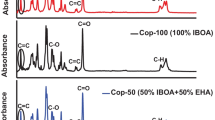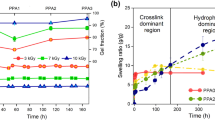Abstract
The radiation-induced gelation of two monomers, acrylic acid and acrylamide, crosslinked using four model compounds was investigated using Fourier transform mechanical spectroscopy. The gel point characteristics of the resulting hydrogels were compared. The gelation characteristics of the two monomers were very similar. The fractal dimensions of the critical gels ranged between 1.77 and 1.82 when the reactions were controlled. The patterns of viscoelastic events of the products at the gel point were also similar, with the matching reactivity of the monomers and the comparable molecular weight of the crosslinkable species, providing a foundation for such events. All of the reactions exhibited low mutation numbers, indicating that the samples tested were quasi-stable during the measurements. The extent of the UV irradiance during crosslinking reactions is an important parameter in the gelation process, with an increase in UV irradiance decreasing the gel times, decreasing the network relaxation exponents (increased fractal dimensions), leading to stiffer critical gels. The evolution of δ with G*, undertaken as van Gurp–Palmen plots, shows that in the fully formed gels, however, the monomer choice and the crosslinker variation can dictate the viscoelasticity of the materials. In particular, the potential for greater steric effects/greater stabilities of the radical active centres of the dimethacrylate species, in comparison with the diacrylate species, resulting in lesser viscoelasticities in the fully formed gels.
Graphic abstract












Similar content being viewed by others
References
Safronov AP, Terziyan TV (2015) Formation of chemical networks of acrylamide and acrylic acid hydrogels initiated by ammonium persulfate. Polym Sci Ser B 57:481–487. https://doi.org/10.1134/S1560090415050140
Magami SM, Williams RL (2018) Gelation studies on acrylic acid-based hydrogels via in situ photo-crosslinking and rheology. J Appl Polym Sci 135:46691. https://doi.org/10.1002/app.46691
Magami SM, Williams RL (2019) Roles of the molecular weight of n-ethylene glycol diacrylates and UV irradiance on the mechanical properties at the gel point of acrylic acid based hydrogels. J Appl Polym Sci 136:47606. https://doi.org/10.1002/app.47606
Laftah WA, Hashim S, Ibrahim AN (2011) Polymer hydrogels: a review. Polym Plast Technol Eng 50:1475–1486. https://doi.org/10.1080/03602559.2011.593082
Mathur AM, Hammonds KF, Klier J, Scranton AB (1998) Equilibrium swelling of poly(methacrylic acid-g-ethylene glycol) hydrogels: EFFECT of swelling medium and synthesis conditions. J Control Release 54:177–184. https://doi.org/10.1016/S0168-3659(97)00186-7
Chen J, Ao Y, Lin T et al (2016) High-toughness polyacrylamide gel containing hydrophobic crosslinking and its double network gel. Polymer (Guildf) 87:73–80. https://doi.org/10.1016/j.polymer.2016.01.069
Jiang G, Deng Z, He Y et al (2019) Cross-linked polyacrylamide gel as loss circulation materials for combating lost circulation in high temperature well drilling operation. J Pet Sci Eng 181:106250. https://doi.org/10.1016/j.petrol.2019.106250
Abdulganiyu U, Magami SM, Aminu M (2017) Graft copolymerization and characterization of styrene with chitosan via radical polymerization. ChemSearch J 8:56–63. https://doi.org/10.4314/csj.v8i1.8
Gardi C, Lungarella G (1984) Detection of elastase activity with a zymogram method after isoelectric focusing in polyacrylamide gel. Anal Biochem 140:472–477. https://doi.org/10.1016/0003-2697(84)90196-9
Decker C (1998) The use of UV irradiation in polymerization. Polym Int 45:133–141. https://doi.org/10.1002/(SICI)1097-0126(199802)45:2%3c133:AID-PI969%3e3.0.CO;2-F
He H, Li L, Lee LJ (2008) Photopolymerization and structure formation of methacrylic acid based hydrogels: the effect of light intensity. React Funct Polym 68:103–113. https://doi.org/10.1016/j.reactfunctpolym.2007.10.006
Samchenko YM, Ul’berg ZR, Komarskii SA et al (2003) Rheological properties of poly(acrylamide-co-acrylic acid) hydrogels. Colloid J 65:78–83. https://doi.org/10.1023/A:1022375109856
Nesrinne S, Djamel A (2017) Synthesis, characterization and rheological behavior of pH sensitive poly(acrylamide-co-acrylic acid) hydrogels. Arab J Chem 10:539–547. https://doi.org/10.1016/j.arabjc.2013.11.027
Ge H, Wang S (2014) Thermal preparation of chitosan–acrylic acid superabsorbent: optimization, characteristic and water absorbency. Carbohydr Polym 113:296–303. https://doi.org/10.1016/j.carbpol.2014.06.078
Mahdavinia GR, Pourjavadi A, Hosseinzadeh H, Zohuriaan MJ, (2004) Modified chitosan 4. Superabsorbent hydrogels from poly(acrylic acid-co-acrylamide) grafted chitosan with salt- and pH-responsiveness properties. Eur Polym J 40:1399–1407. https://doi.org/10.1016/j.eurpolymj.2004.01.039
Yang M, Liu C, Li Z et al (2010) Temperature-responsive properties of poly(acrylic acid-co-acrylamide) hydrophobic association hydrogels with high mechanical strength. Macromolecules 43:10645–10651. https://doi.org/10.1021/ma1022555
Magami SM (2017) In situ viscoelasticity and in situ thermo-responsiveness in acrylic acid-based soft hydrogels. IOP Conf Ser Mater Sci Eng 264:12019. https://doi.org/10.1088/1757-899x/264/1/012019
Zhang SS, Tran DT, Zhang Z (2014) Poly(acrylic acid) gel as a polysulphide blocking layer for high-performance lithium/sulphur battery. J Mater Chem A 2:18288–18292. https://doi.org/10.1039/C4TA04417G
Chrambach A, Rodbard D (1971) Polyacrylamide gel electrophoresis. Science (80- ) 172:440–451. https://doi.org/10.1126/science.172.3982.440
Büyükköroğlu G, Dora DD, Özdemir F, Hızel C (2018) Chapter 15—techniques for protein analysis. In: Barh D, Azevedo V (eds) Omics technologies and bio-engineering: towards improving quality of life. Academic Press, pp 317–351. https://www.sciencedirect.com/science/article/pii/B9780128046593000154?via%3Dihub
Holder AJ, Badiei N, Hawkins K et al (2018) Control of collagen gel mechanical properties through manipulation of gelation conditions near the sol–gel transition. Soft Matter 14:574–580. https://doi.org/10.1039/C7SM01933E
Winter HH (2002) The critical gel BT. In: Borsali R, Pecora R (eds) Structure and dynamics of polymer and colloidal systems. Springer, Dordrecht
Hawkins K, Lawrence M, Williams PR, Williams RL (2008) A study of gelatin gelation by Fourier transform mechanical spectroscopy. J Nonnewton Fluid Mech 148:127–133. https://doi.org/10.1016/j.jnnfm.2007.05.016
Shindel MM, Furst EM (2015) Frequency modulated microrheology. Lab Chip 15:2460–2466. https://doi.org/10.1039/C5LC00351B
Ross-Murphy SB (1994) Rheological characterization of polymer gels and networks. Polym Gels Netw 2:229–237. https://doi.org/10.1016/0966-7822(94)90007-8
Wyss HM (2016) Rheology of Soft Materials. In: Fluids, colloids and soft materials. Wiley, pp 149–163
Winter HH, Chambon F (1986) Analysis of linear viscoelasticity of a crosslinking polymer at the gel point. J Rheol (N Y N Y) 30:367–382. https://doi.org/10.1122/1.549853
Winter HH (1987) Can the gel point of a cross-linking polymer be detected by the G′–G″ crossover? Polym Eng Sci 27:1698–1702. https://doi.org/10.1002/pen.760272209
Scanlan JC, Winter HH (1991) The evolution of viscoelasticity near the gel point of end-linking poly(dimethylsiloxane)s. Makromol Chemie Macromol Symp 45:11–21. https://doi.org/10.1002/masy.19910450105
Chiou B-S, English RJ, Khan SA (1996) Rheology and photo-cross-linking of thiol−ene polymers. Macromolecules 29:5368–5374. https://doi.org/10.1021/ma960383e
Arora D, Winter HH (2010) Network formation in a crystallizing polymer. Polym Mater Sci Eng 103:208–209
Muthukumar M (1989) Screening effect on viscoelasticity near the gel point. Macromolecules 22:4656–4658. https://doi.org/10.1021/ma00202a050
Laukkanen O-V, Winter HH, Seppälä J (2018) Characterization of physical aging by time-resolved rheometry: fundamentals and application to bituminous binders. Rheol Acta 57:745–756. https://doi.org/10.1007/s00397-018-1114-8
Ghiringhelli E, Roux D, Bleses D et al (2012) Optimal Fourier rheometry. Rheol Acta 51:413–420. https://doi.org/10.1007/s00397-012-0616-z
Pogodina NV, Winter HH (1998) Polypropylene crystallization as a physical gelation process. Macromolecules 31:8164–8172. https://doi.org/10.1021/ma980134l
Tokita M, Hikichi K (1987) Mechanical studies of sol–gel transition: universal behavior of elastic modulus. Phys Rev A 35:4329–4333. https://doi.org/10.1103/PhysRevA.35.4329
Magami SM, Williams RL (2019) Gelation via cationic chelation/crosslinking of acrylic acid-based polymers. Polym Int. https://doi.org/10.1002/pi.5910
Chiou B-S, Raghavan SR, Khan SA (2001) Effect of colloidal fillers on the cross-linking of a UV-curable polymer: gel point rheology and the Winter−Chambon criterion. Macromolecules 34:4526–4533. https://doi.org/10.1021/ma010281a
Carey FA, Sundberg RJ (2007) Advanced organic chemistry—part a: structure and mechanisms, 4th edn. Springer, New York
Mours M, Winter HH (1994) Time-resolved rheometry. Rheol Acta 33:385–397. https://doi.org/10.1007/BF00366581
Li X, Zhao Y, Li D et al (2017) Hybrid dual crosslinked polyacrylic acid hydrogels with ultrahigh mechanical strength, toughness and self-healing properties via soaking salt solution. Polymer (Guildf) 121:55–63. https://doi.org/10.1016/j.polymer.2017.05.070
Baker BA, Murff RL, Milam VT (2010) Tailoring the mechanical properties of polyacrylamide-based hydrogels. Polymer (Guildf) 51:2207–2214. https://doi.org/10.1016/j.polymer.2010.02.022
Winter HH (1999) The critical gel—the universal material state between liquid and solid. In: 99 NATO ASI meeting. Les Houches, France
Qin Q, Farrar MJ, Pauli AT, Adams JJ (2014) Morphology, thermal analysis and rheology of Sasobit modified warm mix asphalt binders. Fuel 115:416–425. https://doi.org/10.1016/j.fuel.2013.07.033
Trinkle S, Walter P, Friedrich C (2002) Van Gurp–Palmen plot II—classification of long chain branched polymers by their topology. Rheol Acta 41:103–113. https://doi.org/10.1007/s003970200010
Li R, Yu W, Zhou C (2006) Phase behavior and its viscoelastic responses of poly(methyl methacrylate) and poly(styrene-co-maleic anhydride) blend systems. Polym Bull 56:455–466. https://doi.org/10.1007/s00289-005-0499-6
Rabek JF (1993) Experimental and analytic methods for the investigation of radiation curing. In: Fouassier JP, Rabek JF (eds) Radiation curing in polymer science and technology: fundamentals and methods, 1st edn. Elsevier, London
Jennings J, He G, Howdle SM, Zetterlund PB (2016) Block copolymer synthesis by controlled/living radical polymerisation in heterogeneous systems. Chem Soc Rev 45:5055–5084. https://doi.org/10.1039/C6CS00253F
Shibayama M, Li X, Sakai T (2018) Gels: from soft matter to biomatter. Ind Eng Chem Res 57:1121–1128. https://doi.org/10.1021/acs.iecr.7b04614
Edmondson S, Gilbert M (2017) Chapter 2—the chemical nature of plastics polymerization. In: Gilbert M (ed) Brydson’s plastics materials. Butterworth-Heinemann, pp 19–37. https://www.sciencedirect.com/book/9780323358248/brydsons-plastics-materials
O’Connell CD, Zhang B, Onofrillo C et al (2018) Tailoring the mechanical properties of gelatin methacryloyl hydrogels through manipulation of the photocrosslinking conditions. Soft Matter 14:2142–2151. https://doi.org/10.1039/C7SM02187A
Klotz BJ, Gawlitta D, Rosenberg AJWP et al (2016) Gelatin-methacryloyl hydrogels: towards biofabrication-based tissue repair. Trends Biotechnol 34:394–407. https://doi.org/10.1016/j.tibtech.2016.01.002
Acknowledgements
This work was supported and funded by the Innovate UK agency, under the Knowledge Transfer Partnership programme (KTP). The author acknowledges the helpful discussions provided by Emeritus Professor Jim Guthrie (University of Leeds).
Author information
Authors and Affiliations
Corresponding author
Additional information
Publisher's Note
Springer Nature remains neutral with regard to jurisdictional claims in published maps and institutional affiliations.
Electronic supplementary material
Below is the link to the electronic supplementary material.
Rights and permissions
About this article
Cite this article
Magami, S.M. Comparative gelation of acrylic acid and acrylamide in diacrylate and dimethacrylate crosslinked matrices. Polym. Bull. 78, 1001–1020 (2021). https://doi.org/10.1007/s00289-020-03147-x
Received:
Revised:
Accepted:
Published:
Issue Date:
DOI: https://doi.org/10.1007/s00289-020-03147-x




